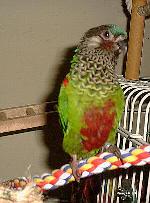Welcome to the
Painted Page!
|
Name: CoCo (Nut) |
Name: Painted Conure (Pyrrhura Picta)
Description: General plumage is green with a narrow band to the area above the beak that is a dark brownish-red. The lores and cheeks are reddish-brown and the lower cheek area has a bluish tinge. Forehead and front of the crown is blue. The back of the crown and head (as well as the nape) are dark brown. The ear-coverts are brownish-white and the sides of the neck, throat, and upper breast are a greyish-brown becoming green on the breast with each feather narrowly edged a whitish to dull yellow giving a scalloped appearance. Has a variable blue band to the nape. The abdomen, lower back, and upper tail-coverts are reddish-brown with the bend of the wing being red, and the primary-coverts and outer webs of the primaries are blue. The upperside of the tail is a brownish-red with a green base and the underside of the tail is a dull brownish-red. Periophthalmic Ring is a dark grey with the Iris being brown. Feet are grey and the beak is a dark grey. Their length is 22 cm (8.5 inches) with a wing length of 115 - 130 mm (4.5 - 5 inches). Immatures look the same as adults but with duller plumage and very little red to the bend of the wing. All Conures are not sexually dimorphic and must be DNA or surgically sexed.**
In The Wild: Painted Conures live in pairs or groups of 5 to 12 birds outside of the breeding season. You occasionally can see larger gatherings on feeding trees and at clay banks along with Golden-winged Parakeets (Brotogeris Chrysopterus) and Pearly Conures (Pyrrhura Perlata). They are not sedentary birds and do not remain long in one location.
Breeding Information: Breeding usually begins in Spring. A clutch usually consists of 4 to 5 eggs (occasionally up to 8). Many eggs are infertile. The incubation period is an average of 23 days. The fledging period is approximately 50 days. Two breedings a year are possible. Does not usually start producing eggs until they are more than 3 years old. Their eggs measure 25.5 x 19.1 mm (1.00 x 0.75 inches).
Temperament: They are an active bird, not too noisy unless excited. Often remain reserved. Off-spring that are bred in aviculture are usually confiding. Inquisitive and enjoys flying. They enjoy bathing and also like to chew fresh branches. They are, however, inclined to feather plucking.**
Diet: This should consist of Pellets, a good Seed Mix (Safflower, Oats, some Sunflower--also sprouted--Hemp, Buckwheat, Millet, Canary Grass Seed and Rowanberries), with plenty of Fruit, Vegetables, and Greens. A regular supply of branches with flowers and buds are also recommended. However, if you are wanting to breed them they will need a more natural diet such as fresh seed and lots of soft, fresh foods. Diets may vary so you should consult your Avian Veterinarian.
** (Please note that not all birds are the same and may vary somewhat in Temperament and Plumage.)
Created by Rio
Designs
Champaign, Illinois
